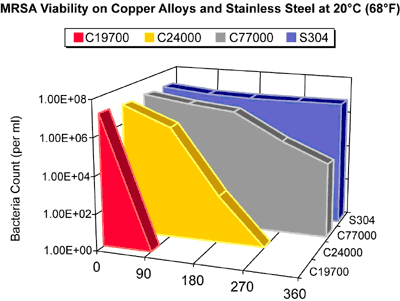The Future of Copper
 A new study shows that drinking water stored in copper and brass containers destroys harmful bacteria within a 48-hour period. This information could help save countless lives worldwide in countries where people lack access to safe drinking water.
A new study shows that drinking water stored in copper and brass containers destroys harmful bacteria within a 48-hour period. This information could help save countless lives worldwide in countries where people lack access to safe drinking water.Copper’s usefulness to humanity will continue to grow in critical areas such as energy efficiency, alternative energies, healthcare, communications, transportation, security and the environment.
The increasing use of copper in healthcare settings can help prevent the spread of harmful bacteria that cause infections. Studies show copper’s naturally antimicrobial properties could reduce cross-contamination from touch surfaces and, in HVAC systems, help improve indoor air quality. Sophisticated microchip and ultra-small nanotechnology applications are also areas where copper outshines other metals because of its superior properties. Copper’s high heat and electrical conductivity enable smaller, coolerrunning components.
Copper already is used to generate and distribute electricity from natural resources like sunlight, water and wind. These technologies will likely become more widespread as America looks to renewable energy sources to reduce its reliance on oil. Further into the future, we may even see specially strengthened copper used to advance nuclear fusion as an alternative energy source.
In transportation, hybrid electric vehicles with highly conductive and compact copper motors will become more efficient and ubiquitous. Light rail vehicles, using copper in motors and cabling, will also grow in popularity to support commuters who want to avoid high gas prices.
Copper’s key properties — electrical conductivity and flexibility also — assure its future in home technology, another area of expected growth, as Americans increasingly automate their homes and wire them for whole-house Internet, audio, video and security systems. The reliable transmission of highbandwidth data and video is made possible with telecom and computer cables containing copper.
The recent development of all-copper diecast motor rotors holds great promise for improving the energy efficiency of consumer and industrial electrical products. Yet another avenue of investigation is increasing the wear resistance of copper-based electrical contacts to ensure the smooth flow of energy and increased product reliability.
 One of the deadliest types of bacteria found in hospitals today is MRSA, a so-called "superbug" that does not respond to conventional antibiotics. Research shows that copper can stop the spread of MRSA by limiting the time the bacteria are able to live on its surface. This chart show that MRSA bacteria thrive on stainless steel (blue) but die off quickly on copper (red) and copper alloy surfaces.
One of the deadliest types of bacteria found in hospitals today is MRSA, a so-called "superbug" that does not respond to conventional antibiotics. Research shows that copper can stop the spread of MRSA by limiting the time the bacteria are able to live on its surface. This chart show that MRSA bacteria thrive on stainless steel (blue) but die off quickly on copper (red) and copper alloy surfaces.Copper will continue to contribute in environmentally sound ways. Its long life cycle and high recycling rate makes copper the greenest of metals in architecture and building construction. The use of copper to remove contaminants from petroleum, as well as detect potential bacterial agents in aboveground water supplies, is also being researched.
Copper is also being used to enhance new radio frequency identification (RFID) technology used for security, tracking and purchasing systems in retail, manufacturing, transportation and distribution. For example, gas stations use RFID to allow customers to pay at the pump with a small wand that holds their credit card information. Copper increases the distance at which this “invisible” technology will work.
Look forward to novel ways that copper will beautify our lives. Inventive fabrication and application methods will enable architectural copper to enhance exteriors in an array of colors and textures. Interiors will benefit from copper’s allure in kitchen appliances, countertops and other surfaces — residential and commercial.
Today, tomorrow and well into the future, copper will continue to reveal its timeless beauty as well as its extraordinary range of inherent physical and mechanical attributes.
Also in this Issue:
- Four Decades of Innovation: Issues 1 - 25
- Four Decades of Innovation: Issues 26 - 60
- Four Decades of Innovation: Issues 61 - 99
- Copper Shines on Prime Time
- The History of Copper
- The Future of Copper
